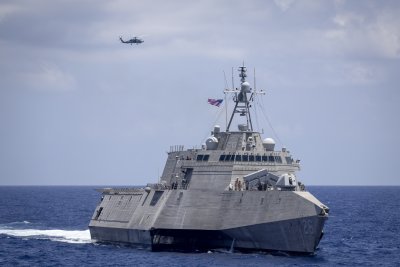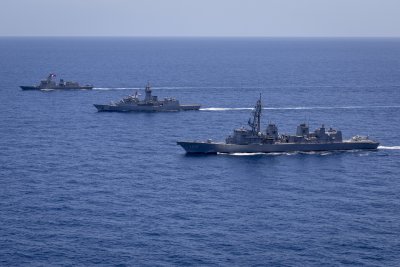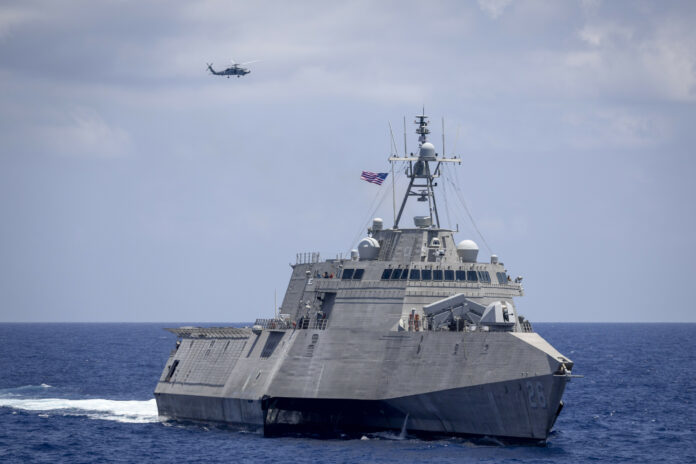The United States and Australia continued joint naval deployments in the contested South China Sea this week, despite protests from Beijing.
The U.S. Navy’s Seventh Fleet said on Tuesday that the USS Mobile, an Independence-class littoral combat ship, operated in the waters the previous day alongside the Australian navy’s Anzac-class frigate HMAS Warramunga.
Both warships were part of a multinational naval joint patrol on Sunday in support of Manila—the U.S.’s oldest treaty ally in Asia—which is pushing back against sweeping Chinese territorial claims in the Philippines exclusive economic zone.
A Chinese government spokesperson warned this week that U.S.-led military activity in the region must not undermine China’s security or territory rights. The Chinese Defense Ministry did not immediately return Newsweek‘s request for comment.
“The U.S. Navy regularly participates with allies and partners in high-end maritime exercises and operations, which have continued to grow in scale, scope, and complexity, to create combined operations that enhance interoperability, boost deterrence, and demonstrate shared resolve,” the Japan-based Seventh Fleet said in its statement.
Commodore Jonathan Ley, who leads Australia’s joint force maritime component, was quoted as saying: “Opportunities to operate with allies and partners while in the region enhance our ability to respond cooperatively to shared security challenges.”
The allies did not say how long their deployment in the South China Sea would last.
The U.S. has stepped joint patrols with the Philippines in recent months amid flare-ups involving Beijing and Manila’s coast guards in the Spratly Islands archipelago.
Unprecedented Chinese water cannon attacks that have injured Philippine navy sailors have led to debates throughout the region about the threshold for triggering Article 5 of the U.S.-Philippines Mutual Defense Treaty.
1 of 2
POIS Leo Baumgartner/Royal Australian Navy

POIS Leo Baumgartner/Royal Australian Navy

POIS Leo Baumgartner/Royal Australian Navy
The four-nation Maritime Cooperative Activity on April 7 involved the Philippine navy’s Jose Rizal-class frigate BRP Antonio Luna and the Alvarez-class patrol ship BRP Valentin Diaz.
The U.S. Navy deployed the Mobile alongside a P-8A Poseidon maritime patrol aircraft, while Australia also sent an air force P-8 alongside the Warramunga.
Japan’s Maritime Self-Defense Force said it dispatched the Murasame-class destroyer JS Akebono for joint drills that included anti-submarine warfare and tactical maneuvring exercises.
Gen. Romeo Brawner Jr., the Philippines armed forces chief of staff, said the allied flotilla was shadowed by two Chinese warships, whose classes and hull numbers he did not identify.
Also on Tuesday, the Chinese military’s Southern Theater Command, responsible for operations in the South China Sea, said its naval and air force conducted their own patrols from April 7 to 8, overlapping with the U.S.-led maneuvers.
The command published images earlier of Chinese surveillance aircraft taking off to practice activities including “anti-submarine” sorties.
“If the concerned parties intend to escalate tensions in the South China Sea and undermine China’s territorial and sovereign integrity, then they will become the PLA’s target,” China’s nationalistic Global Times newspaper said in an editorial on Monday, referring to the Chinese People’s Liberation Army.
“This is not ambiguous and is the correct signal that the concerned parties should receive from the actions of the PLA,” the state-owned tabloid added.
Uncommon Knowledge
Newsweek is committed to challenging conventional wisdom and finding connections in the search for common ground.
Newsweek is committed to challenging conventional wisdom and finding connections in the search for common ground.


